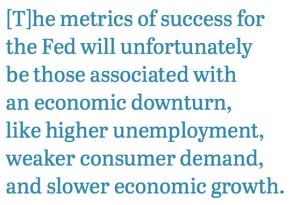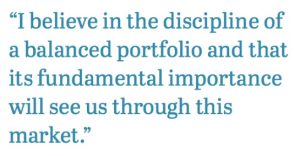
Chief Executive Officer, Sonya Mughal, CFA, chats with Chief Investment Officer, Eric Leve, CFA, about 2022’s steep challenges and prospects for the economy and the markets in the new year.
Eric Leve, CFA: Sonya, a year ago at this time we had a conversation that turned out to be rather prescient. We shared our frustration at the backward-looking nature of our industry and lamented the impact laser-focused market watchers had on economics at the expense of geopolitics. We even spent a little time discussing Russia’s increasingly militaristic tone with Ukraine. 2022 turned out to be a painful year for investors, driven by markets previously priced for perfection and the actions of geopolitical forces in Ukraine and beyond. Let’s risk talking big picture again and then turn our focus to the markets.
Sonya Mughal, CFA: That works for me. Starting at the top, 2022 brought the largest land war in Europe since World War II, the most significant nuclear risk since the Cuban Missile Crisis, and the unsettling recognition that our modernity doesn’t make borders sacrosanct. Europe was brutally forced to face the folly of its energy dependence on a well-endowed, but mercurial, neighbor. At times during the year, the future of industrial Europe seemed at risk.
 But Europe pivoted quickly, building its first floating liquid natural gas terminal in under 200 days, enabling it to import natural gas from a broader range of suppliers. Energy continues to create strange bedfellows… at this point, Europe and the U.S. are reaching out to a variety of African nations and restarting conversations with Venezuela on getting access to energy. The evidence from 2022 also suggests that Saudi Arabia is aligning itself closer to Russia’s interests than the West’s. We will definitely be talking about this for the next few years as Europe falls back on dirtier solutions to fill the energy gap while, at the same time, accelerating its transition to alternative energy sources and building a broader portfolio of import partners.
But Europe pivoted quickly, building its first floating liquid natural gas terminal in under 200 days, enabling it to import natural gas from a broader range of suppliers. Energy continues to create strange bedfellows… at this point, Europe and the U.S. are reaching out to a variety of African nations and restarting conversations with Venezuela on getting access to energy. The evidence from 2022 also suggests that Saudi Arabia is aligning itself closer to Russia’s interests than the West’s. We will definitely be talking about this for the next few years as Europe falls back on dirtier solutions to fill the energy gap while, at the same time, accelerating its transition to alternative energy sources and building a broader portfolio of import partners.
Eric: No doubt Europe will remain top of mind, but China could be the ‘Russia of 2023’. Even before the 20th National Congress of the Communist Party of China in October, President Xi Jinping demonstrated a clear pivot away from the markets and the economy toward nationalism and party orthodoxy. It was a bitter symbol of his narrowing group of confidants to see former President Hu Jintao’s forceful removal from the stage at the 20th Party Congress. Isolated, paranoid leaders can be dangerous.
Then, toward the end of the year, the nation dramatically unwound much of its zero-COVID policy. The action may have been due to growing street protests, but more likely it was a recognition that economic sustenance is vital to party allegiance. If it was the latter, it should bode well for increased fiscal stimulus from the Chinese government in 2023. This stimulus will be a critical piece of stronger global economic activity next year.
In contrast, most Western governments have nearly exhausted their ability to stimulate their economies, as outstanding debt has become more expensive to finance and budgets are stretched. Stimulus from China could be the critical piece that drives revenues for a broad range of global companies and partially offsets economic recessions expected in Europe, the U.S., and elsewhere. In a perverse struggle between fears of global recession and ongoing inflation, the growth benefits from China’s reopening may get chalked up as a net negative if it generates price pressures (especially on commodities) through the year.
Sonya: For me, the big question is, “How does China deal with its failure to be #1?” Based on demographics and expectations of economic growth, China may never overtake the U.S.’s position as the world’s largest economy. China’s rapidly aging population will become an increasing burden to a nation that has never really escaped the “middle income trap.” If this is something of a peak for China in terms of global economic clout, could that embolden its military to be more aggressive in the short-term? Here, I’m obviously thinking of Xi’s desire for “reunification” with Taiwan and the continued building of islands in the South China Sea.
Eric: I think the aggressive offshoring by Taiwanese chipmakers says that your fears are well-founded. And the powerful codependent relationship between China and Russia clarifies a new arrangement of the post-Cold War geopolitical landscape.
Now that we’ve poured out a bit of our geopolitical anxiety closet, let’s turn to economics and the markets. After almost two years of inflation spiking in various ways across the globe, central bankers recognized that they weren’t facing just a post-pandemic boom. Starting in the first quarter of 2022, a more entrenched inflationary environment began to bring back painful memories of the 1970s.
Sonya: Exactly. After facing inflation driven by the supply chain, prices continued to rise even as consumers reduced their demand for goods. In 2022, services drove consumer demand, wage pressures accelerated and, due to the Ukrainian invasion, commodities added an unsettling inflationary tailwind. The Fed is clearly going all-in on beating down inflation and, in doing so, accepting a deeper recession. The job market continues to be too strong to rein in wages and inflation. This means the metrics of success for the Fed will unfortunately be those associated with an economic downturn, like higher unemployment, weaker consumer demand, and slower economic growth.
The picture in Europe and the UK is, if anything, more challenging. Inflation remains higher and economic weakness persists, yet both central banks also bias their actions toward controlling inflation at the expense of growth. Quite simply, 2023 may bring us the most anticipated global recession in memory.
Eric: On the surface, such a bleak economic outlook doesn’t sound like a constructive environment for investment markets, but I’d say there are potentially a number of bright spots for investors in 2023.
With the hindsight of looking at the financial picture at year-end 2021, one has to admit that markets were priced to perfection. The S&P 500 was priced at 22.7x 2022 earnings. Three-month U.S. Treasurys were yielding essentially 0% and, even 10-year bonds only provided a yield of 1.5%. Equity investors had enjoyed years of a tailwind fueled by low interest rates. And that quickly broke down under the building inflation pressures of 2022 and demonstrated that bonds with no yield provide little to no diversification relative to stocks.
Sonya: Yes. The contrast is quite remarkable. As of the last trading day of 2022, 10-year Treasurys were yielding 3.9% and much of the equity market was very cheap compared to the history of the past 20 years. Quite simply, the long-term forecasts for market returns are dramatically improved, and the value of asset allocation is likely stronger now.
Even so, the near-term is much harder to forecast and there are no guarantees for 2023. A deep recession could lead to disappointing earnings and even lower stock valuations. Alternatively, with most observers expecting a recession, there is significant upside potential if that doesn’t occur, both in companies’ earnings and how investors value them. The middle ground between these outcomes might be my base case: earnings won’t grow much, or at all (especially in inflation-adjusted terms), but lower interest rates could drive valuations higher, pointing to a neutral outlook for equities over the next year.
 Eric: Getting a little granular, we’re seeing valuations across smaller companies beginning to look more compelling versus their large cap brethren. After nine months of remarkable strength, the U.S. dollar has declined precipitously over the last quarter but still looks overvalued to me relative to most major currencies. Differences in central bank policies around the globe could point to further dollar weakness in 2023, leading to a good backdrop for both developed and emerging market equities. So, yes, I concur. While the challenges are considerable, stocks in 2023 could perform pretty well, even without an earnings tailwind!
Eric: Getting a little granular, we’re seeing valuations across smaller companies beginning to look more compelling versus their large cap brethren. After nine months of remarkable strength, the U.S. dollar has declined precipitously over the last quarter but still looks overvalued to me relative to most major currencies. Differences in central bank policies around the globe could point to further dollar weakness in 2023, leading to a good backdrop for both developed and emerging market equities. So, yes, I concur. While the challenges are considerable, stocks in 2023 could perform pretty well, even without an earnings tailwind!
Sonya: Indeed. I believe in the discipline of a balanced portfolio and that its fundamental importance will see us through this market. The cheapening of stocks, the variation in valuations among them, higher interest rates, and the prospect of lower inflation all point to a return to the efficacy of broad asset allocation. Phrases such as “cash is trash” have been the norm for the past decade. With the prospect of further Fed rate hikes early in 2023, we may see cash yields above 5%, a far cry from the zero yields offered for much of the last several years. Significantly, for investors who expect lower correlations between stocks and bonds in the short term and for those looking out a decade or more, the markets provide a much more constructive starting point than they did at the end of 2021.
Recent Insights
Bailard Appoints Dave Harrison Smith, CFA, as Chief Investment Officer
Bailard is pleased to announce that, as of today, Dave Harrison Smith, CFA, has been promoted to Chief Investment Officer. He succeeds Eric Leve, CFA, who held the role for more than a decade and will continue with the firm as a portfolio manager, fully focused on international markets.
July 1, 2025
Country Indices Flash Report – June 2025
Tariff negotiations intensified as the July 9th reciprocal tariff deadline nears, though the Trump administration signaled flexibility on the cutoff for countries negotiating in “good faith.” The U.S. and China secured a high-level framework that included a key rare earths deal and a tariff truce extension to August 11th. Meanwhile, the UK finalized a 10% tariff rate after a threatened 27.5%; talks are swiftly progressing with the EU.
June 30, 2025
Mike Faust Awarded 2025 Advisors to Watch by AdvisorHub
Michael Faust, CFA, ranked in the top five of AdvisorHub’s Advisors to Watch for the second year—recognizing his standout leadership at Bailard.
June 24, 2025
Keep Informed
Get the latest News & Insights from the Bailard team delivered to your inbox.